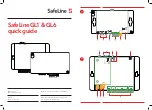
254
Definition of Key Codes
Syntax Description
When using the Telnet applet available under the Portal’s Advanced tab,
there is an option to specify a keymap URL that points to a key code
definition file. If your application uses a different keyboard layout than the
standard VT320, a key code definition file can be created and uploaded
to the keymap URL. This appendix shows how to create the key code
definition file. Almost all special keys can be defined according to the
following syntax rule:
[SCA] KEY=STRING
The characters enclosed in [ and ] are optional. Only one of the characters
’S’
(SHIFT),
’C’
(CTRL) or
’A’
(ALT) may appear before KEY, which is
a textual representation of the key you wish to redefine (F1, PGUP and
so on.).
The new STRING to be sent when pressing the key should come after
the equals character (=). Hash marks (#) in the file declare the line as a
comment and will be ignored. The following examples explains the syntax
in more detail:
Send the string "test" when pressing the F1 key:
F1 = test
On pressing C PGUP, send the string "pgup pressed":
CPGUP = pgup pressed
Redefine the key Alt + F12 to send an escape character:
AF12 = \\e
As can be seen, the string may contain special characters which may be
escaped using the backslash (\).
Allowed Special Characters
The following table includes allowed special characters:
Note:
For some of the escape codes you need two backslashes, as
these are specific javassh definitions not known by the Java Property
mechanism.
Nortel VPN Gateway
User Guide
NN46120-104
02.01
Standard
14 April 2008
Copyright © 2007-2008 Nortel Networks
.
Summary of Contents for NN46120-104
Page 299: ......
















































